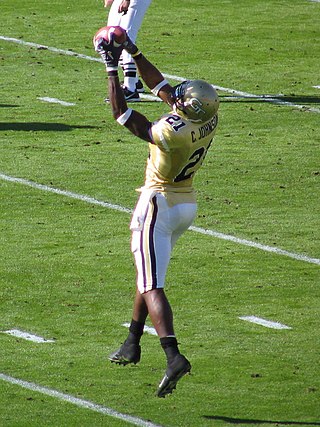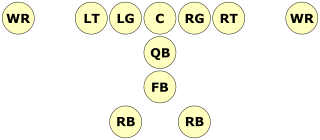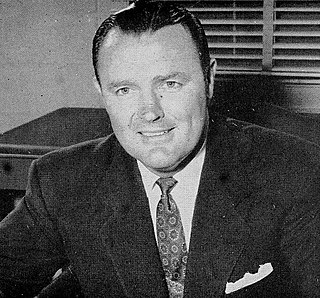Related Research Articles

A wide receiver (WR), also referred to as a wideout, and historically known as a split end (SE) or flanker (FL), is an eligible receiver in gridiron football. A key skill position of the offense, WR gets its name from the player being split out "wide", farthest away from the rest of the offensive formation.
A draw play, or simply draw for short, is a type of American football play. The draw is a running play disguised as a passing play. It is the opposite of a play-action pass, which is a passing play disguised as a running play. The play is often used in long yardage situations.

An option offense is an American football offensive system in which a key player has several "options" of how each play will proceed based upon the actions of the defense. Traditionally, option-based offenses rely on running plays, though most mix in forward passes from an option formation as a change of pace. A successful option-based offense can keep possession of the ball for long periods of time, giving the opposing offense fewer possessions and keeping the option team's defense rested. However, because passing is often not a strength of the system, it can be difficult for option-based offenses to come back from a large deficit or to score quickly when needed.

The wishbone formation, also known simply as the bone, is an offensive formation in American football. The style of attack to which it gives rise is known as the wishbone offense. Like the spread offense in the 2000s to the present, the wishbone was considered to be the most productive and innovative offensive scheme in college football during the 1970s and 1980s.

In American football, a T formation is a formation used by the offensive team in which three running backs line up in a row about five yards behind the quarterback, forming the shape of a "T".

Donald Burrows Faurot was an American football and basketball player, coach, and college athletics administrator best known for his eight-decade association with the University of Missouri. He served as the head football coach at Northeast Missouri State Teachers College—commonly known at the time as Kirksville State Teachers College and now known as Truman State University—from 1926 to 1934 and at Missouri from 1935 to 1942 and again from 1946 to 1956. During World War II, Faurot coached the Iowa Pre-Flight Seahawks in 1943 and the football team at Naval Air Station Jacksonville in 1944. He was also the head basketball coach at Kirksville State from 1925 to 1934, tallying a mark of 92–74. Faurot was the athletic director at Missouri from 1935 to 1942 and again from 1946 to 1967. He lettered in three sports at Missouri in the early 1920s: in football, as a halfback, basketball and baseball.

James Moore "Big Jim" Tatum was an American football and baseball player and coach. Tatum served as the head football coach at the University of North Carolina at Chapel Hill, the University of Oklahoma (1946), and the University of Maryland, College Park (1947–1955), compiling a career college football record of 100–35–7. His 1953 Maryland team won a national title. As a head coach, he employed the split-T formation with great success, a system he had learned as an assistant under Don Faurot at the Iowa Pre-Flight School during World War II. Tatum was also the head baseball coach at Cornell University from 1937 to 1939, tallying a mark of 20–40–1. Tatum's career was cut short by his untimely death in 1959. He was inducted into the College Football Hall of Fame as a coach in 1984.

The spread offense is an offensive scheme in gridiron football that typically places the quarterback in the shotgun formation, and "spreads" the defense horizontally using three-, four-, and even five-receiver sets. Used at every level of the game including professional, college, and high school programs across the US and Canada, spread offenses often employ a no-huddle approach. Some implementations of the spread also feature wide splits between the offensive linemen.
In American football, a play is a close-to-the-ground plan of action or strategy used to move the ball down the field. A play begins at either the snap from the center or at kickoff. Most commonly, plays occur at the snap during a down. These plays range from basic to very intricate. Football players keep a record of these plays in a playbook.

The Veer is an option running play often associated with option offenses in American football, made famous at the collegiate level by Bill Yeoman's Houston Cougars. It is currently run primarily on the high school level, with some usage at the collegiate and the professional level where the Veer's blocking scheme has been modified as part of the zone blocking system. The Veer is an effective ball control offense that can help minimize mismatches in a game for a team. However, it can lead to turnovers with pitches and handoff option reads.
The following terms are used in American football, both conventional and indoor. Some of these terms are also in use in Canadian football; for a list of terms unique to that code, see Glossary of Canadian football.
The 1946 Oklahoma Sooners football team represented the University of Oklahoma as a member of the Big Six Conference during the 1946 college football season. Led by Jim Tatum in his first and only season as head coach, the Sooners compiled an overall record of 8–3 with a mark of 4–1 in conference play, sharing the Big 6 title with Kansas. Oklahoma was invited to the Gator Bowl, where they defeated NC State. With the aid of first-year backfield coach Bud Wilkinson, who became the team's head coach the following year, Tatum installed the new split-T offense.
From 1947 to 1955, Jim Tatum served as the head coach of the Maryland Terrapins football team, which represented the University of Maryland in National Collegiate Athletic Association (NCAA) college football. Maryland hired Tatum to replace Clark Shaughnessy after the 1946 season. Tatum had created both success and controversy during his one season as head coach of the Oklahoma Sooners football team. During his nine-year tenure, Tatum became one of the most successful head football coaches in Maryland history, and the Terrapins compiled two national championships, three conference championships, and five bowl game appearances. His teams compiled a 73–15–4 record without a single losing season, and as of the end of 2016, he has the highest winning percentage of any Maryland football coach who coached at least seven games. In 1954, the University of Maryland appointed a new president, Dr. Wilson Elkins, who chose to de-emphasize football. Following the 1955 season, Tatum took a pay cut to coach at his alma mater, North Carolina, and he died four years later.
The 1950 Gator Bowl was the fifth edition of the Gator Bowl and featured the Missouri Tigers representing the University of Missouri and the Maryland Terrapins representing the University of Maryland. It was the first-ever meeting of the two teams.
The 1954 Orange Bowl was a postseason American college football bowl game between the first-ranked Maryland Terrapins and the fourth-ranked Oklahoma Sooners. It was the twentieth edition of the Orange Bowl and took place at the Orange Bowl stadium in Miami, Florida on January 1, 1954.

In American football, the 5–2 defense is a defensive alignment consisting of five down linemen and two linebackers.

In American football, the 4–4 defense is a defensive alignment consisting of four down linemen and four linebackers.
In American football the air raid offense refers to an offensive scheme popularized by such coaches as Mike Leach, Hal Mumme, Sonny Dykes, and Tony Franklin during their respective tenures at Iowa Wesleyan University, Valdosta State, Kentucky, Oklahoma, Texas Tech, Louisiana Tech, and Washington State.
The run and shoot offense is an offensive system for American football which emphasizes receiver motion and on-the-fly adjustments of receivers' routes in response to different defenses. It was conceived by former high school coach Glenn "Tiger" Ellison and refined and popularized by former Portland State offensive coordinator Mouse Davis.
References
- ↑ "Don Faurot's split-T Formation". University of Missouri. Retrieved 2006-07-07.
- ↑ Maisel, Ivan (November 7, 2012). "Darrell Royal meant more than wins". ESPN . Retrieved November 8, 2012.
- ↑ Bible, p. 115.
- ↑ Brown and Clary, pp. 82-83.
- ↑ Faurot, Chapter 12.
- ↑ Faurot, Chapters 3-5.
- ↑ Faurot, p. 31.
- ↑ Faurot, pp. 13-15.
- ↑ Madsen, Rob (Spring 2023). "The Cost of Conservatism: The University of Minnesota's Lofted Ideals and Fallen Football Teams". Journal of Sport History. 50 (1): 85–100.
- ↑ Gary King, The Forgotten Man of Oklahoma Football: Jim Tatum Archived 2009-02-22 at the Wayback Machine , Sooner Magazine, University of Oklahoma Foundation, Inc., Spring 2008, retrieved 17 December 2008.
- ↑ Vic Gold, The Greatest Game, Washingtonian Magazine, 1 January 2002, retrieved 20 December 2008.
- ↑ "Wilkinson Created Sooner Dynasty". ESPN.com. Retrieved 2006-07-07.